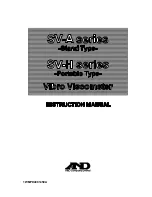
Circuit Description—Type
P6042
Amplifier
Operation
When
the current waveform in
the
conductor
under
test
(see
Fig.
3-3A) is
applied
to
the
transformer
core
in
the
probe,
the
signal
is
seen
at
the
input
of
the
low-frequency
amplifier
(through
the
Hall
device)
and
at
the
input
of
the
high-fre
quency amplifier
(through
the
secondary
winding
in
the
probe).
The
low-frequency
or
DC
information
from
the
Hall
device
is
amplified
and
applied
to
the
input
of
the
high
fre
quency
amplifier
(see
Fig.
3-3B).
The
high-frequency
infor
mation
applied
to
the
amplifier
(see
Fig.
3-3C)
combines
with
the
low-frequency
information,
producing
the
resultant
waveform
(see Fig.
3-3D)
at
the
output,
an
accurate
repre
sentation
of
the original
signal.
The
portion
of
the
signal
amplified
by
each
of
the
two
stages
depends
upon
the
frequency
of
the
signal
being
meas
ured.
If
the signal
is near
DC,
the
output
of
the
low-frequency
amplifier
closely
resembles
the
original
signal.
Conversely
with
higher
frequency
signals, only
the
DC
level
is
seen
by
the
low-frequency
amplifier.
Probe Degaussing
Whenever
a
magnetic
field
is
applied
to
the
transformer
core in
the
probe
with
the
system turned
off,
or
if
a
current
beyond
the
maximum
specified level is applied,
the
probe
may
be
magnetized. A
portion
of
this
magnetic
flux
is likely
to
remain
in
the
current probe
core,
causing
erroneous
meas
urements.
To
remove
this
flux,
a
degauss
circuit
(Q73
and
Q79)
is
provided.
With
the
probe
inserted
in
the
front-panel
receptacle,
SW70
closes
and
allows
operation
of
the
degauss
circuit.
When
the
DEGAUSS
lever
is
depressed,
the
50-turn
secondary
is removed
from
the
amplifier
and
connected to the
output
of
the
degauss
oscillator
Q73
and
Q79.
C65
(charged
to
+16
volts)
is
applied
to
the
circuit,
which
oscillates
at
approixmately
10
kilohertz.
As
C65
discharges,
the
ampli
tude
of
the
oscillator
signal
decays
exponentially,
degaussing
the
probe
core.
The
time
required
for
probe degaussing
is
about
200
milliseconds.
See Fig.
3-4.
Q31,
which
is normally
off, is
associated
with
the
degauss
circuit.
To
successfully
degauss
the
probe
core,
the
junction
of
R46
and
R56
must
be
near
zero
volts
when
the
DEGAUSS
lever
is
released.
When
the
DEGAUSS
lever
is depressed
Q31
turns
on,
bringing
the
bases
of Q44,
Q53
and
the
out
put
of
the
current
amplifier
near
zero
volts.
When the
DEGAUSS
lever
is
released, C33
discharges
and
slowly
turns
Q31
off,
thereby
preventing
a
transient
from being
applied
to
the
50-turn
coil
by
the
current
amplifier.
3-4
Summary of Contents for P6042 PROBE
Page 3: ......
Page 4: ...Characteristics Type P6042 Fig 1 1 P6042 Current Probe and accessories...
Page 7: ...Characteristics Type P6042 1 3...
Page 8: ...Characteristics Type P6042 1 4...
Page 10: ...Operating Instructions Type P6042 Fig 2 2 Function of front panel controls and connectors 2 2...
Page 28: ...NOTES...
Page 30: ...Calibration Type P6042 Fig 6 1 Test equipment recommended 6 2...
Page 46: ...NOTES...
Page 64: ...HE RMAL COUPLER SEE PARTS LIST FOR SEMICONDUCTOR TYPES AMPLIFIER MRH S...
Page 65: ...P 6 042 CURRENT PROBE DC TO 50MHz...
Page 66: ...FIG 1 P6042 PROBE PACKAGE STANDARD ACCESSORIES P6042 PROBE...
Page 67: ...FIG 2 P6042 PROBE MECHANICAL PARTS...
Page 68: ...FIG 3 AMPLIFIER PO...
Page 69: ...3 AMPLIFIER POWER SUPPLY P6042 PROBE...
Page 70: ...FIG 4 CABINET...
Page 71: ...FIG 4 CABINET P6042 PROBE...















































